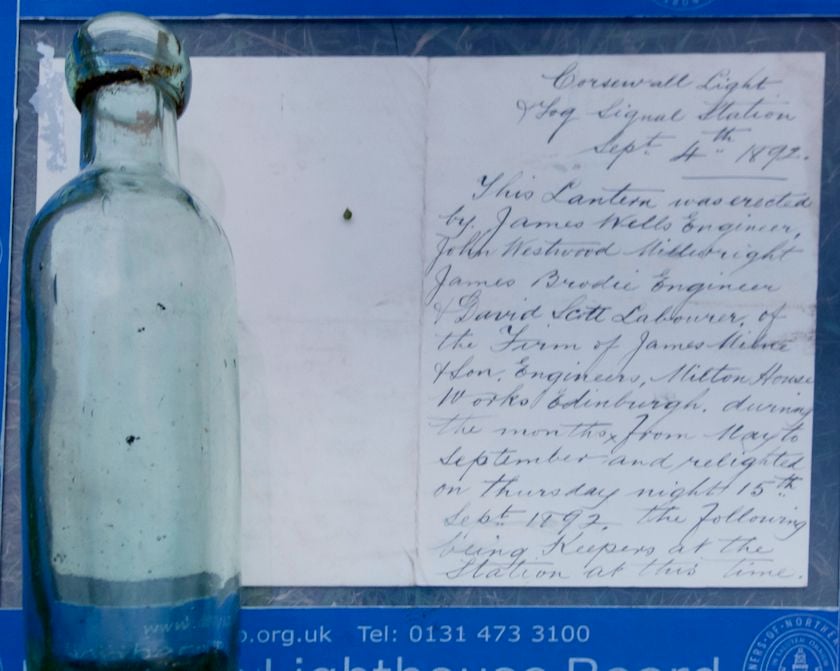The letter inside the glass bottle was dated September 4, 1892.
John Harris / Corsewall Lighthouse Hotel
In 1892, engineers installed a new lens and lantern at the top of the Corsewall Lighthouse in Scotland—a major project that took them the entire summer to complete.
Once they had finished their work and re-illuminated the lighthouse, the team sat down with a quill, an inkwell and a piece of paper. In cursive, they wrote their names and briefly explained the project, then rolled up the paper and slid it inside a glass bottle. They plugged the top with an old cork wrapped in wire, then tucked the bottle inside a cavity in the lighthouse’s wall.
There the bottle remained, unbeknownst to anyone over the ensuing decades. But last month, engineers were once again at the lighthouse making some repairs. While working on the historic structure, they stumbled upon the glass bottle with the note inside.
When they fished the note out of the bottle and read it, the engineers were stunned: They were working on the very same lens described in the 132-year-old missive. “It was a direct communication from them to us,” says Barry Miller, the lighthouse keeper, to the New York Times’ Isabella Kwai.
Here’s the full text of the note:
Corsewall Light & Fog Signal Station, Sept. 4th 1892.
This lantern was erected by James Wells Engineer, John Westwood Millwright, James Brodie Engineer, David Scott Labourer, of the firm of James Milne & Son Engineers, Milton House Works, Edinburgh, during the months from May to September and relighted on Thursday night 15th Sept. 1892.
The following being keepers at the station at this time, John Wilson Principal, John B Henderson 1st assistant, John Lockhart 2nd assistant.
The lens and machine being supplied by James Dove & Co. Engineers Greenside Edinburgh and erected by William Burness, John Harrower, James Dods. Engineers with the above firm.
Corsewall Lighthouse is perched at the tip of a peninsula in southwest Scotland, overlooking the Irish Sea and the mouth of Loch Ryan. Established around 1817 in the village of Kirkcolm, it has dutifully guided ships along the rocky coast for two centuries.
A keeper lived on-site and operated Corsewall Lighthouse until 1994, when the flashing light was automated. Today, it’s monitored remotely from Edinburgh at the offices of the Northern Lighthouse Board. With a team of technicians, keepers and engineers, the board is responsible for maintaining and operating more than 200 lighthouses in Scotland and the Isle of Man.
The keeper’s quarters were sold and transformed into a hotel and restaurant. Overnight visitors can now choose whether to stay in the original building or in more modern structures built on the 20-acre grounds. The property is also home to an Iron Age fort called Dunskirloch.
“It’s a hidden gem,” John Harris, who co-owns the hotel with his partner Helen Mason, told the Herald’s Deborah Anderson in 2021. “We’ve got some of the oldest rock formations in the U.K. … There are four resident deer, seals, porpoises and a sea otter has been seen swimming around the lighthouse.”
The lighthouse overlooks the Irish Sea and the mouth of Loch Ryan in southwest Scotland.
John Harris / Corsewall Lighthouse Hotel
Meanwhile, the light at the top of the 112-foot tower still flashes white every 30 seconds.
“It’s amazing to think that the work they did back then is still completely relevant today, even in the age of satellite navigation,” says Euan Murray, whose great-great-great-grandfather Robert Murray worked at the lighthouse, to BBC News’ Angie Brown.
For now, the message in a bottle is being kept at the Northern Lighthouse Board’s offices in Edinburgh. But once crews finish renovating the lighthouse, they plan to return the bottle to its original hiding place.
Next to it, today’s engineers and lighthouse keepers plan to stash another bottle with their own note. “Sometime in the future, perhaps, we will be able to communicate to someone else,” Miller tells the Times.


